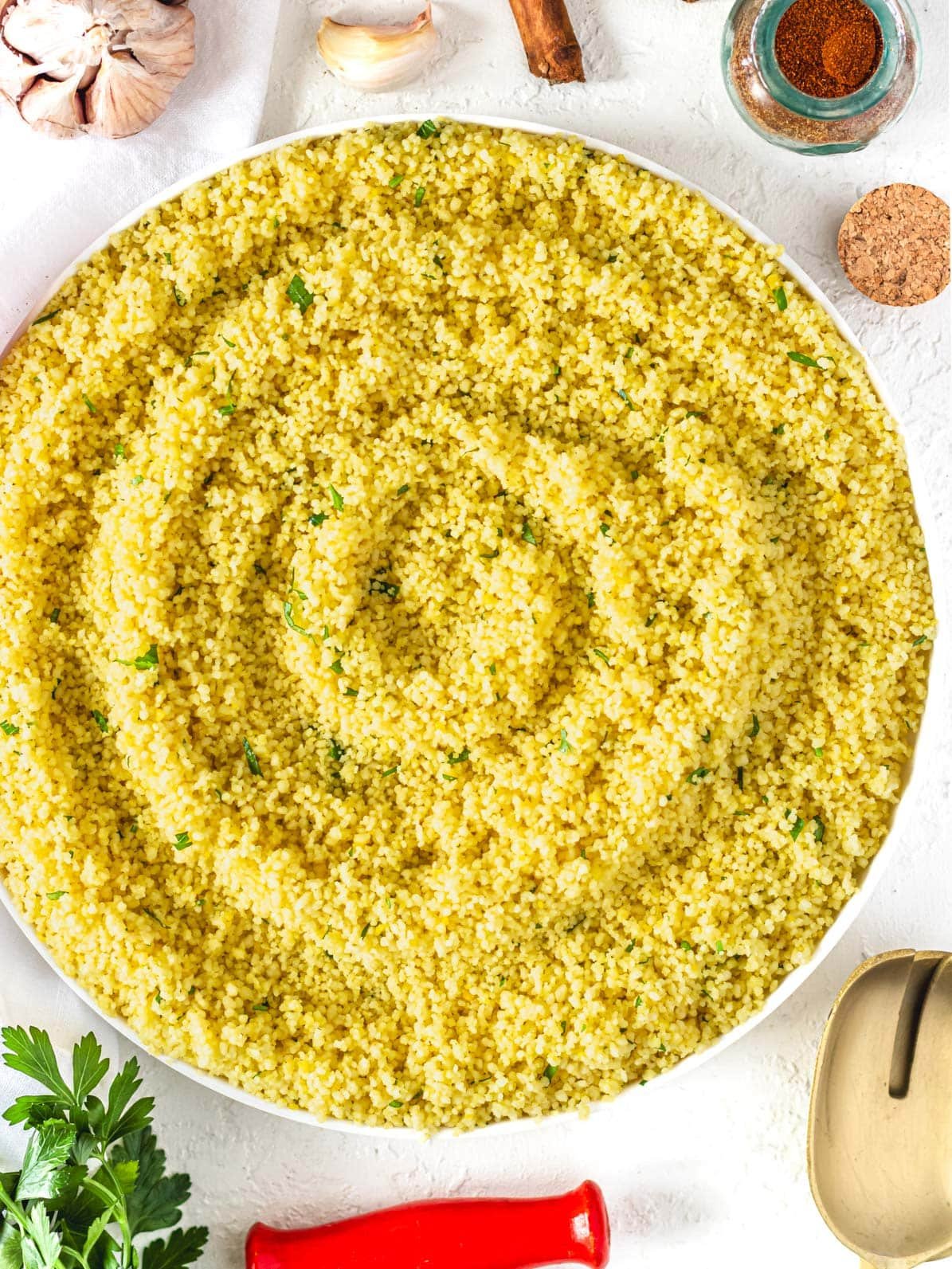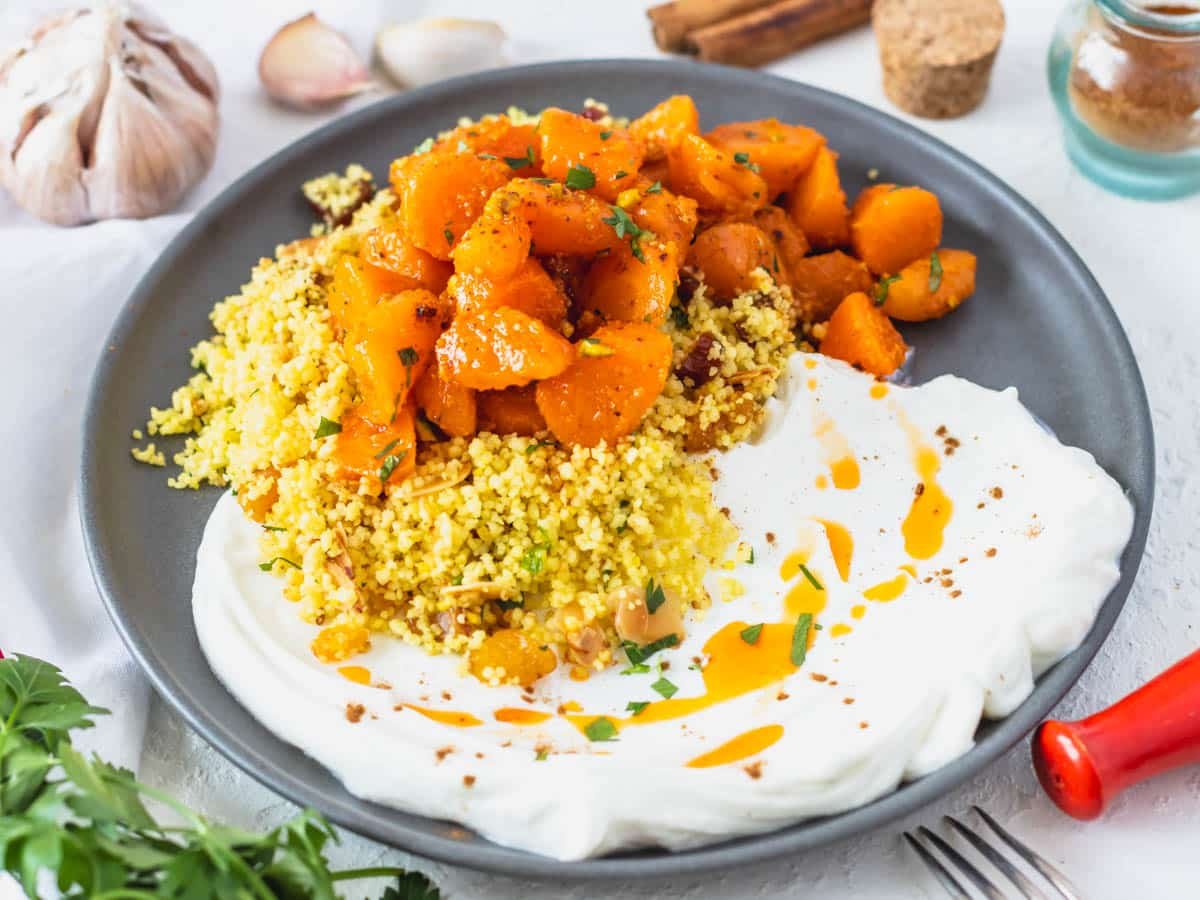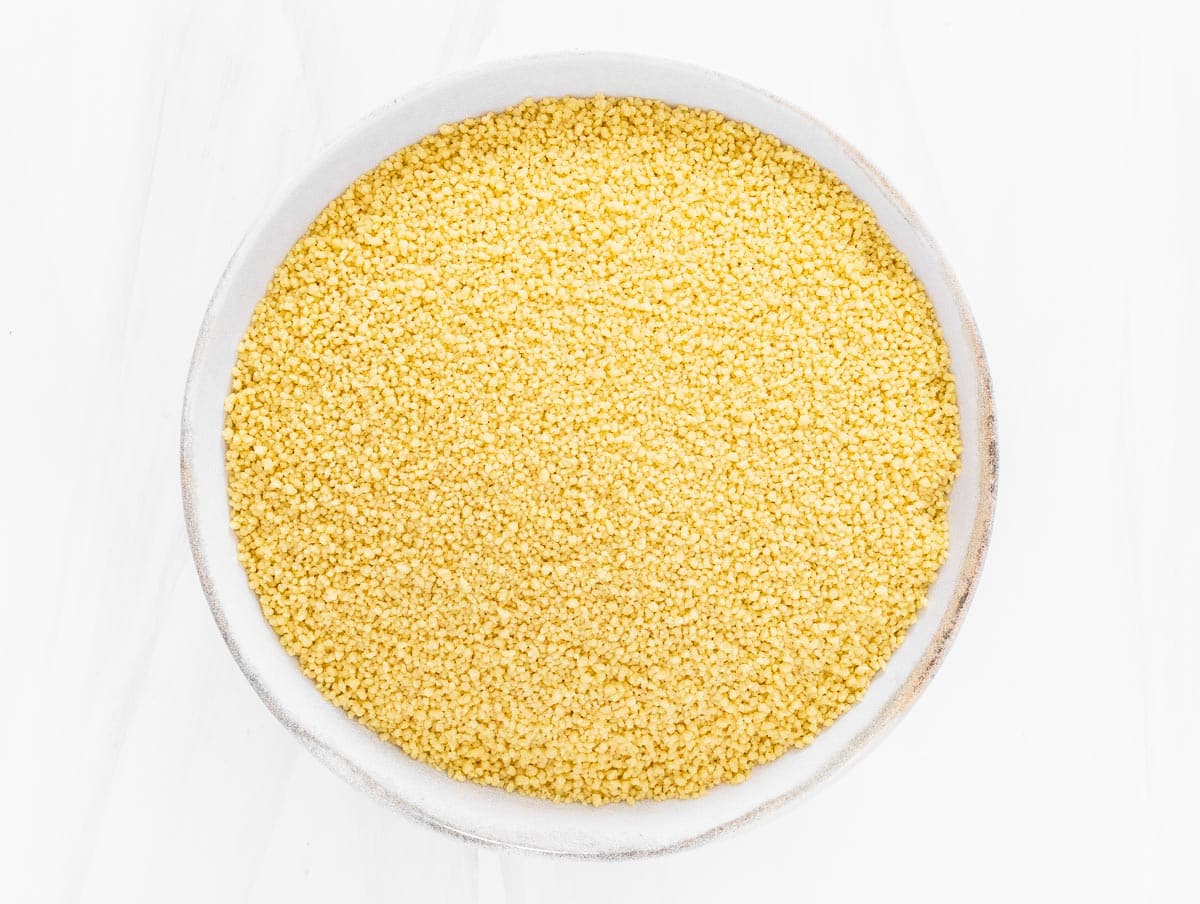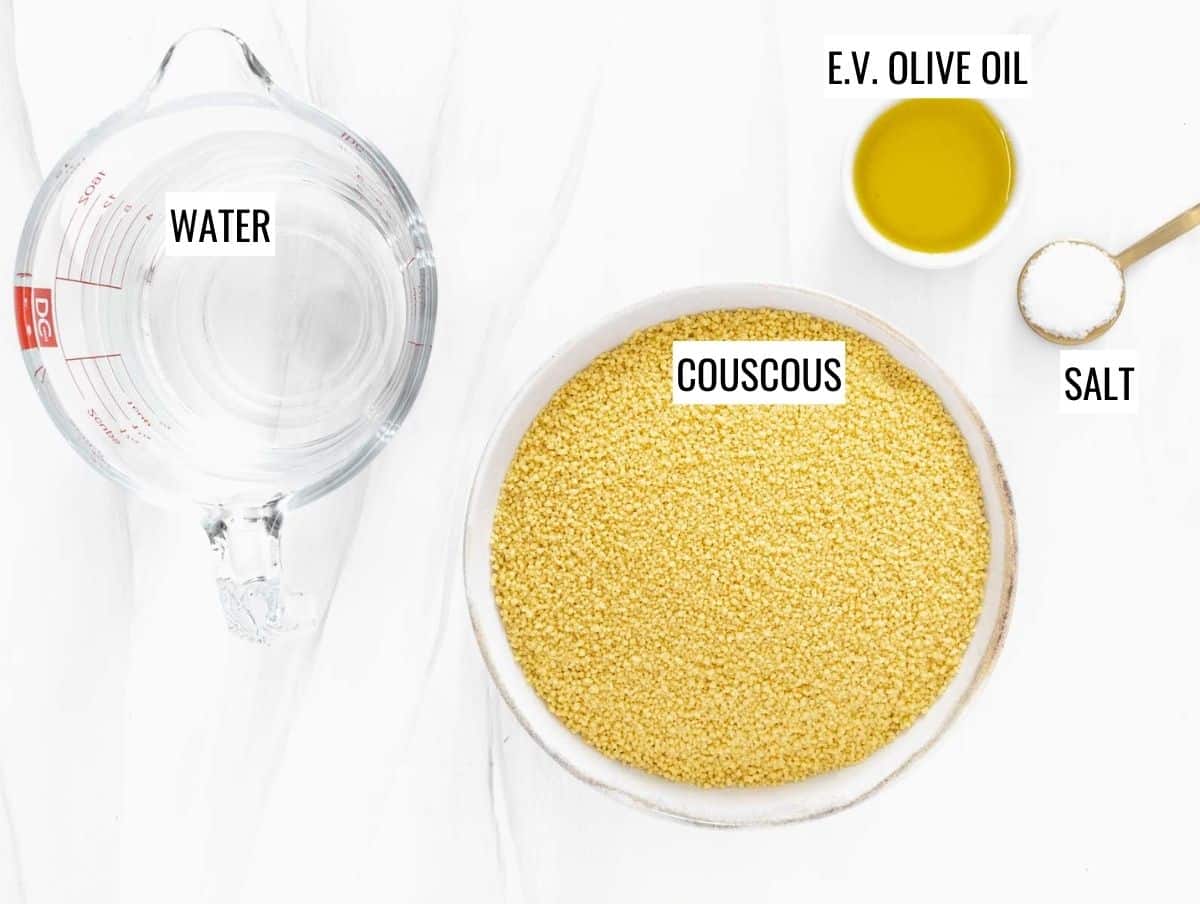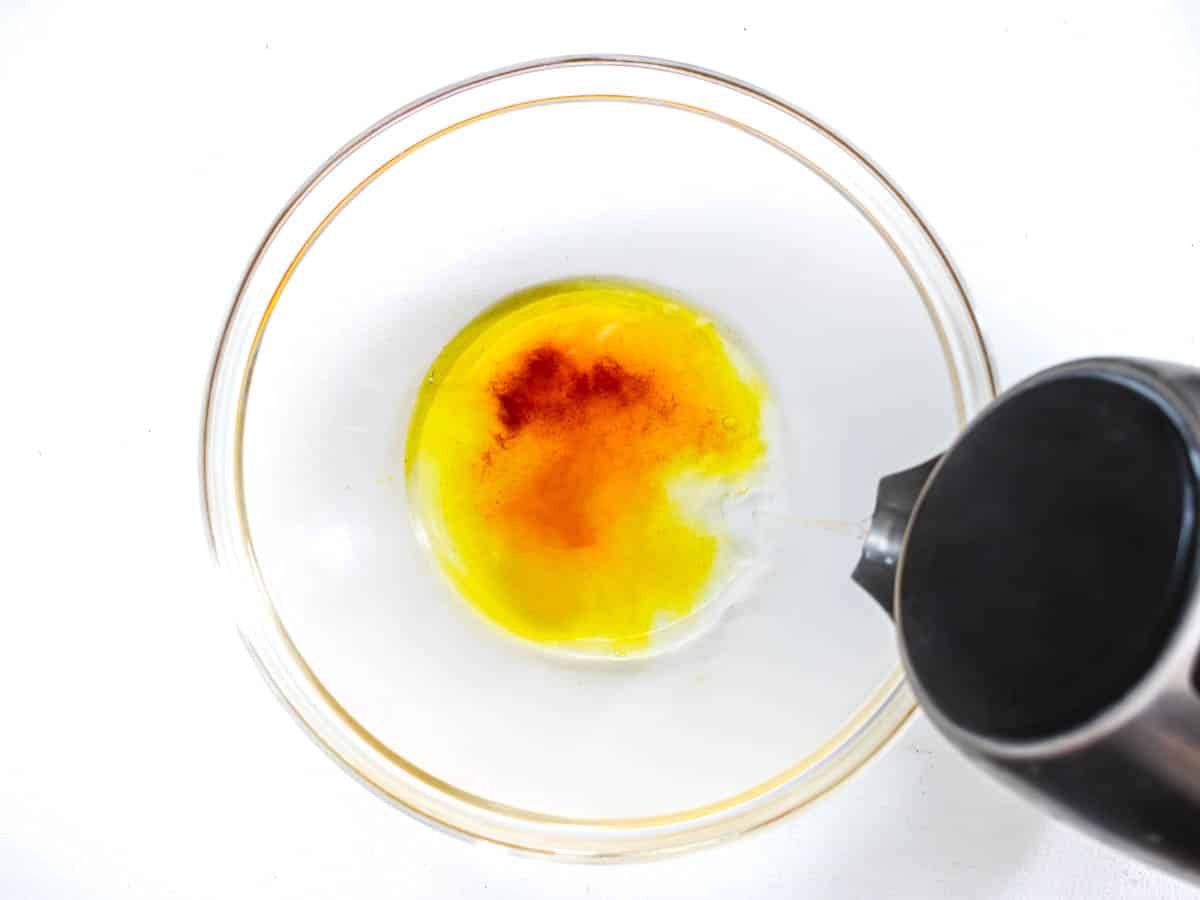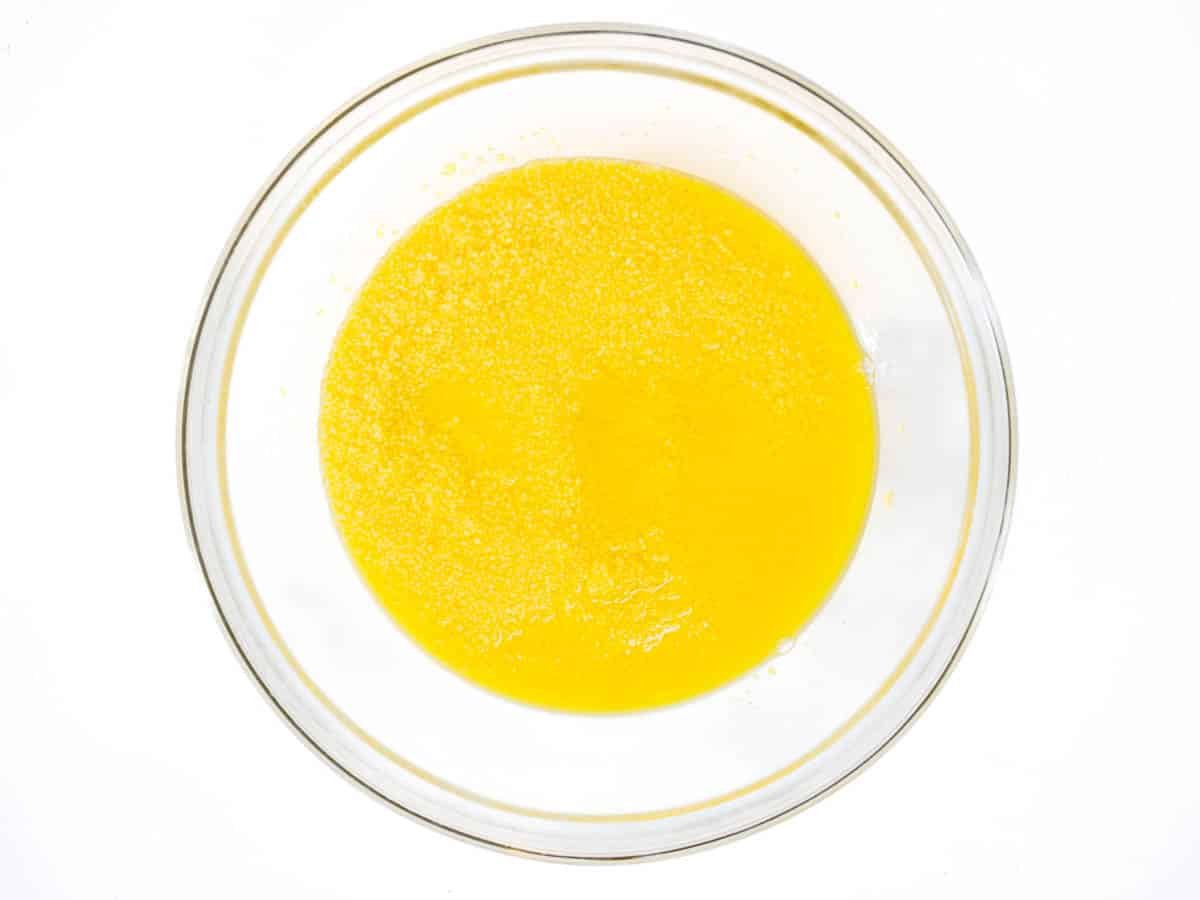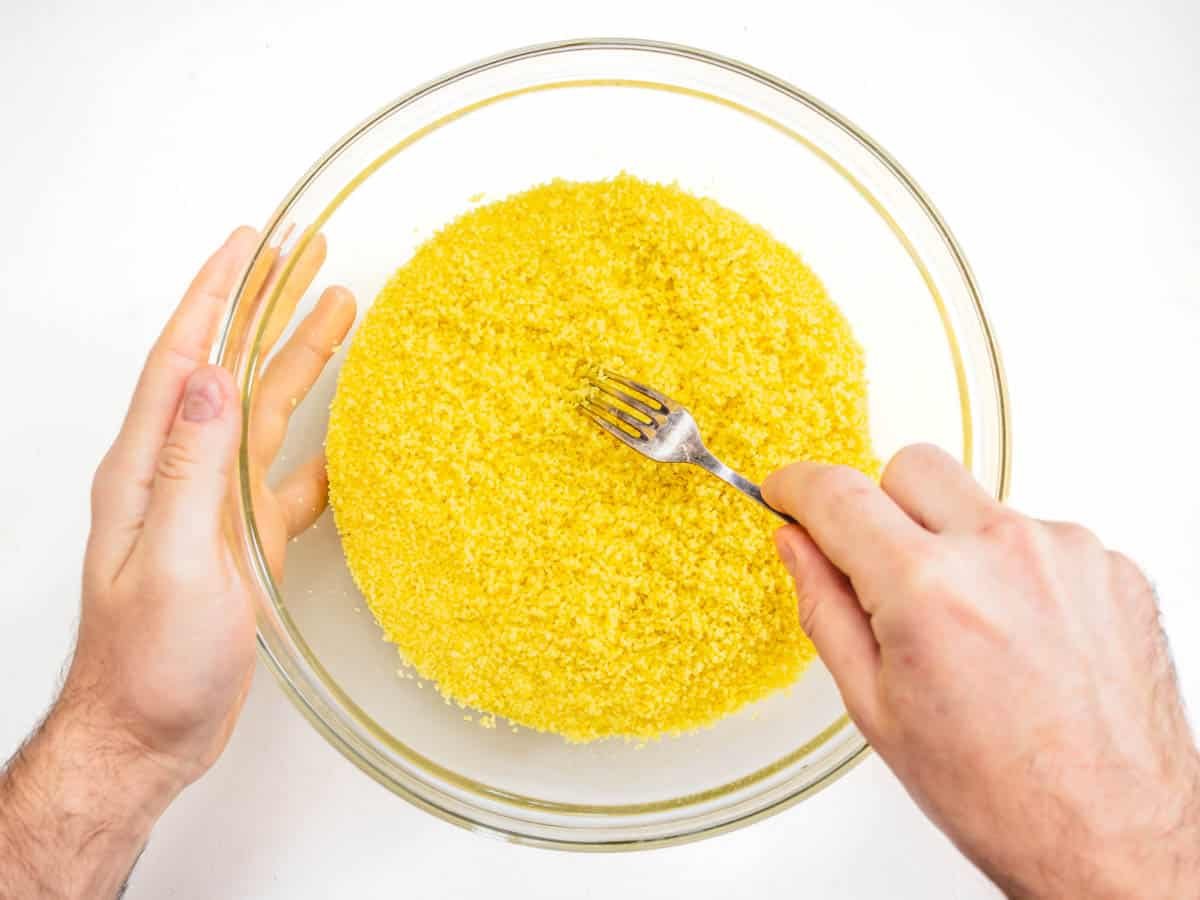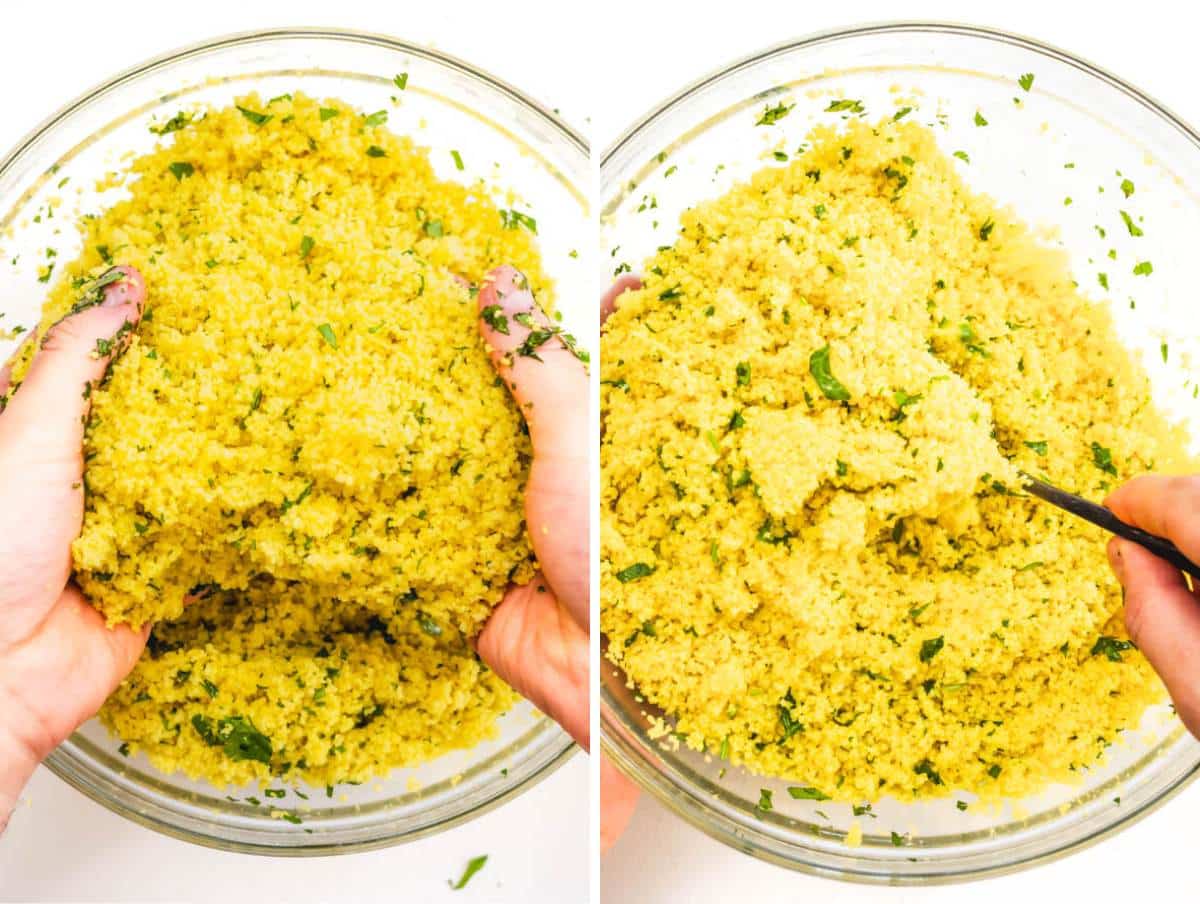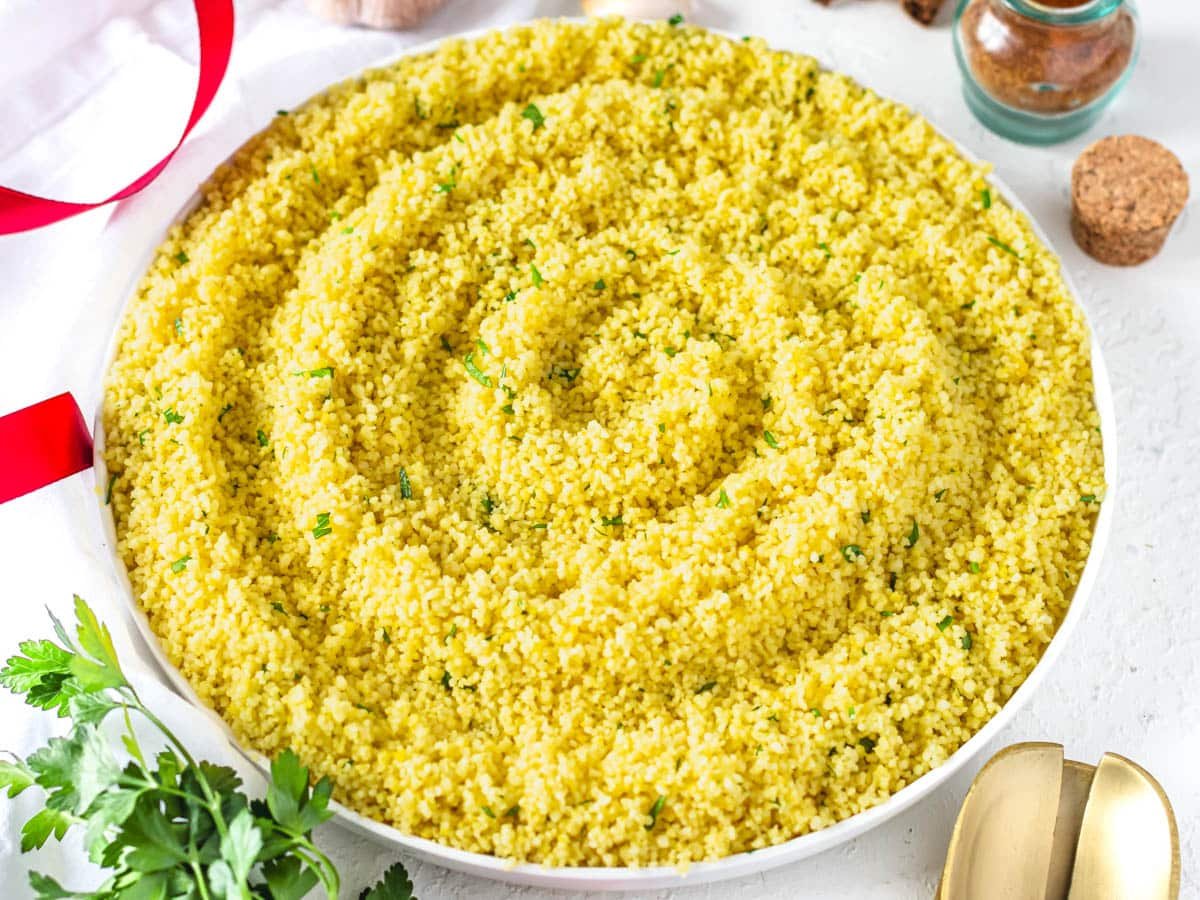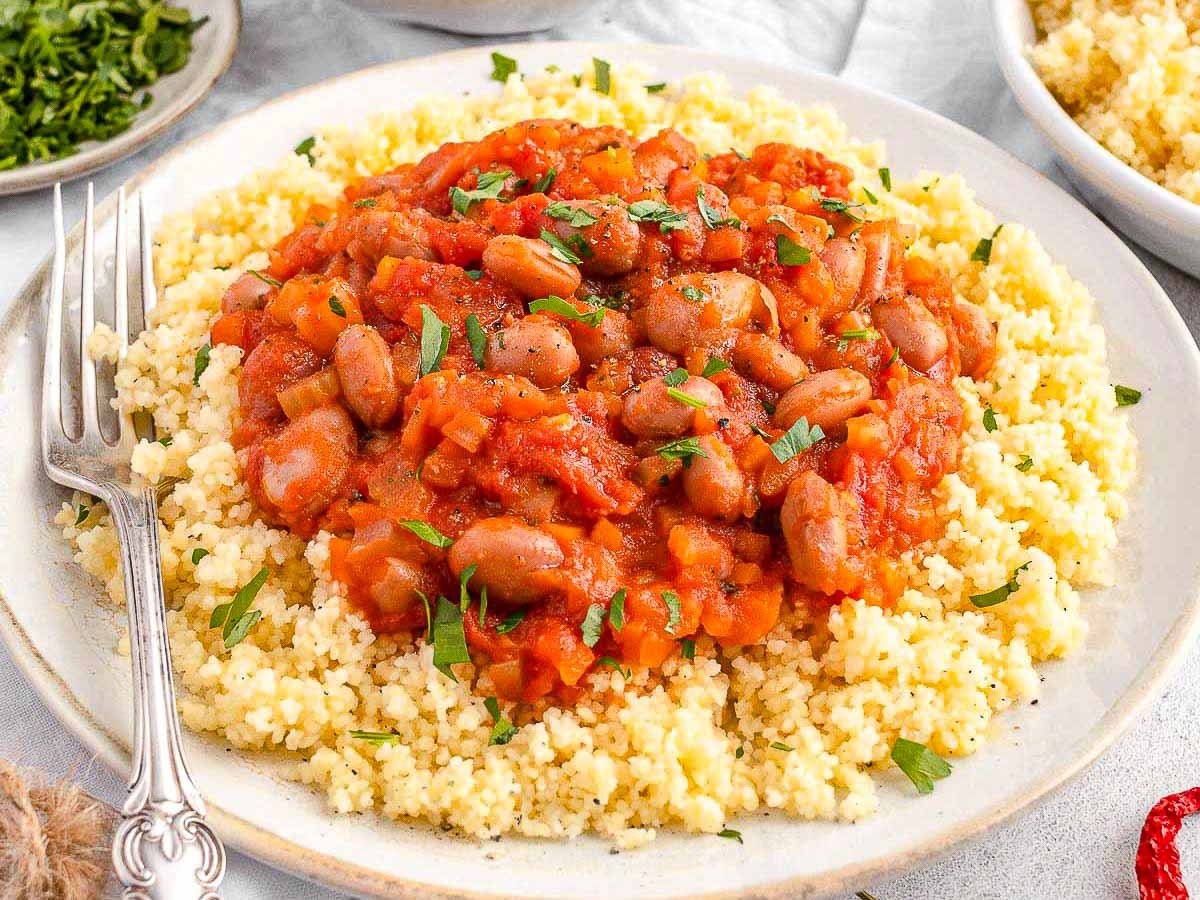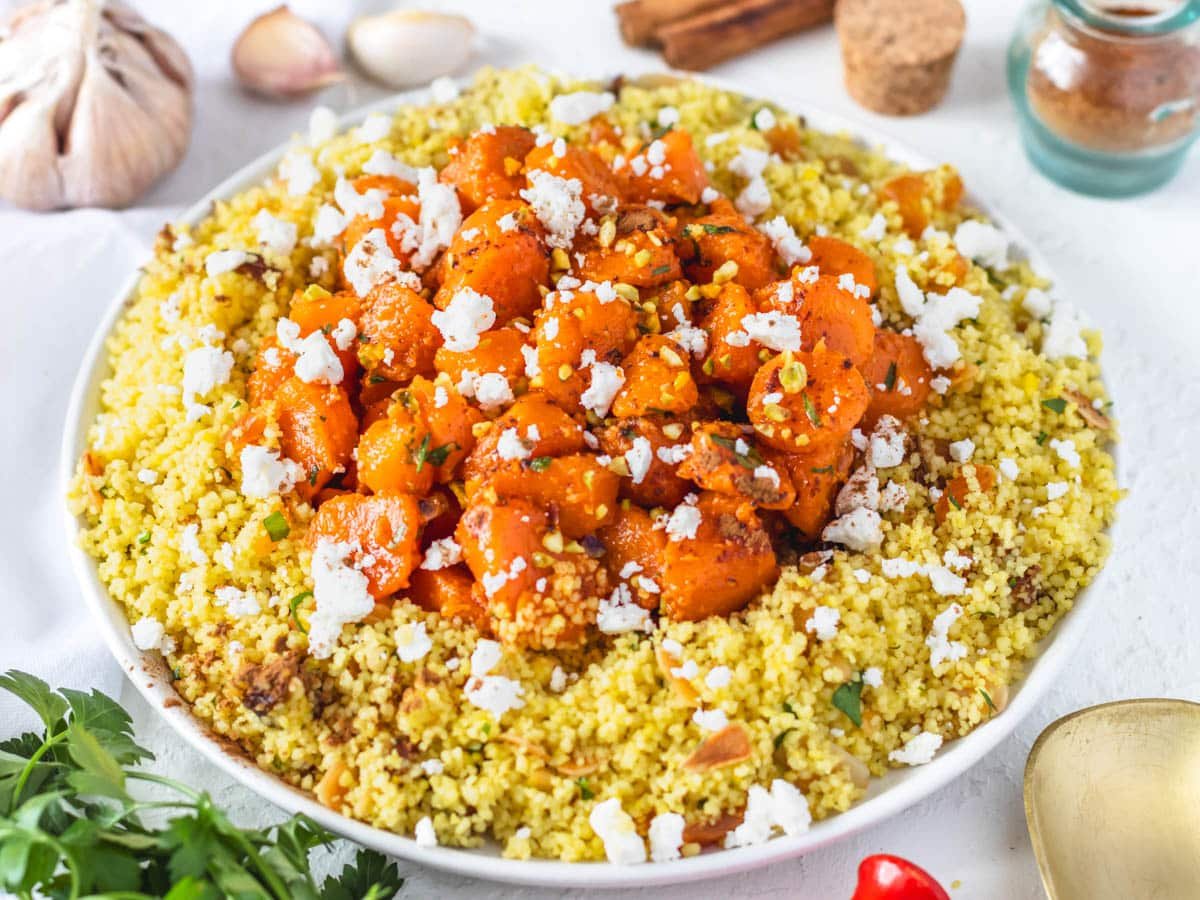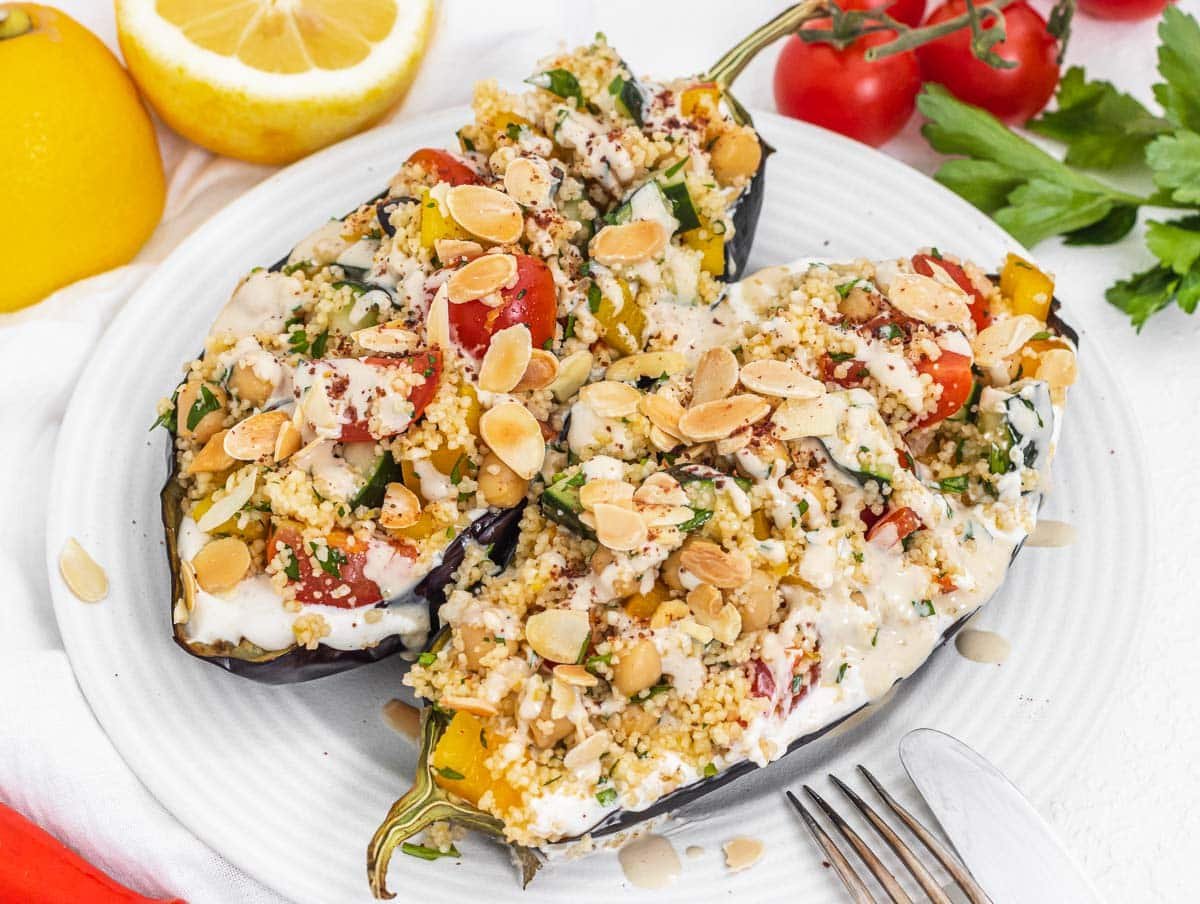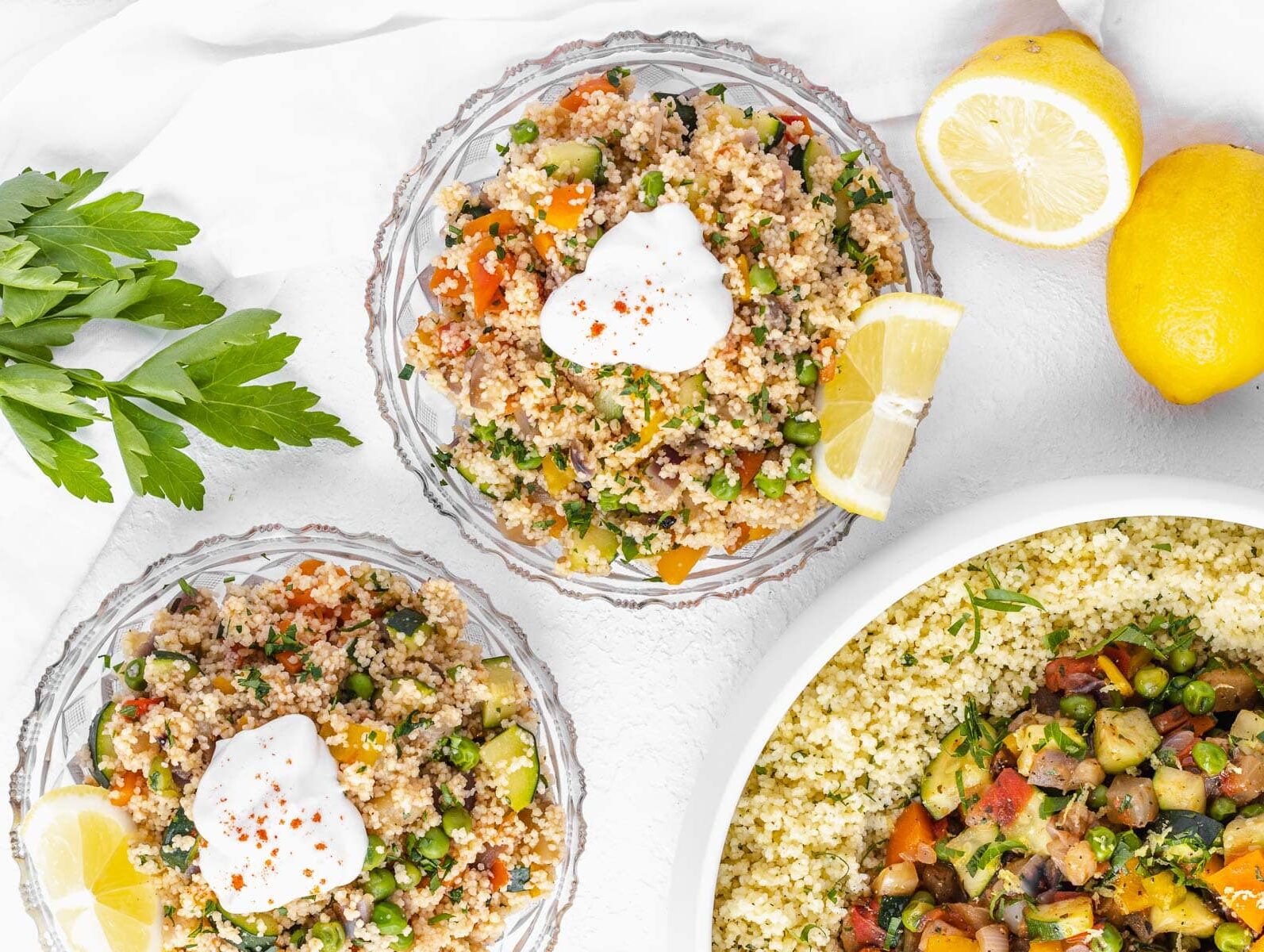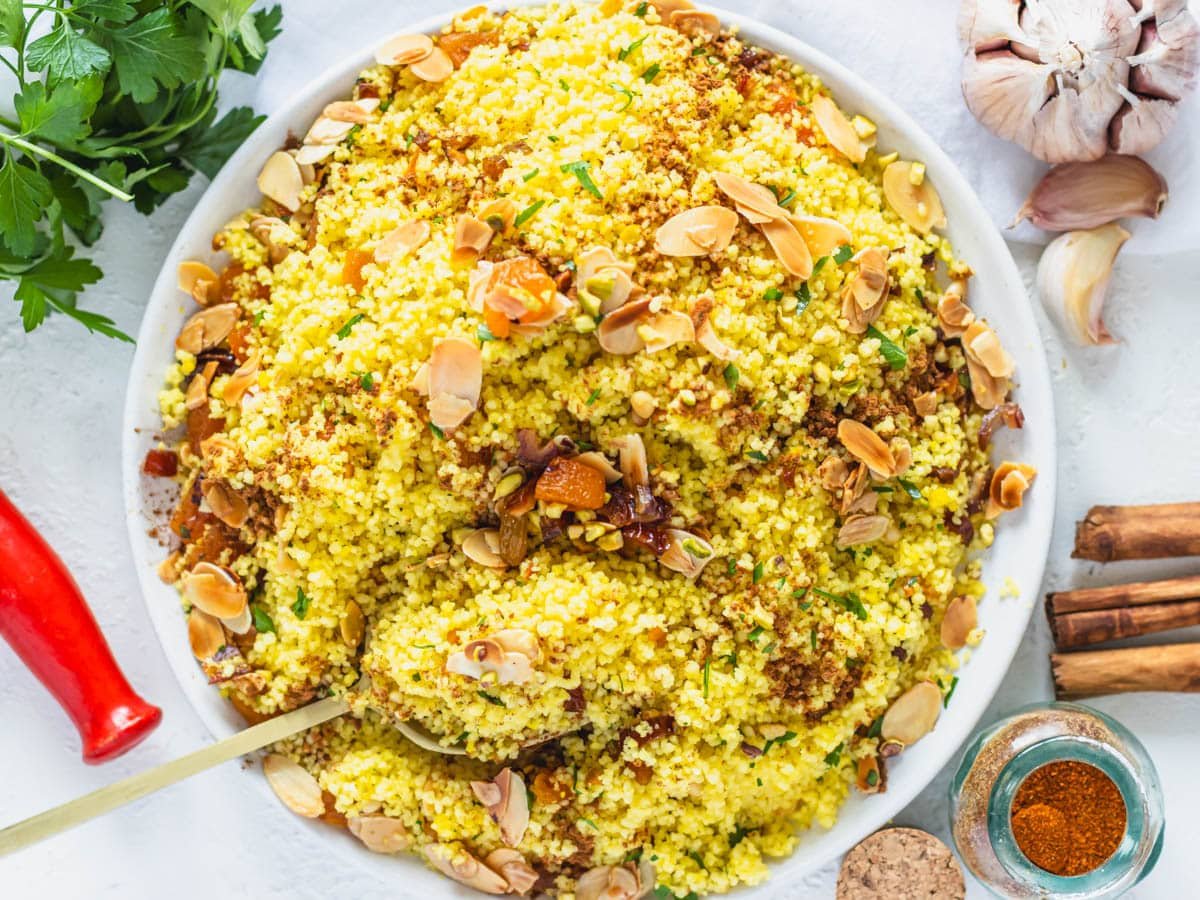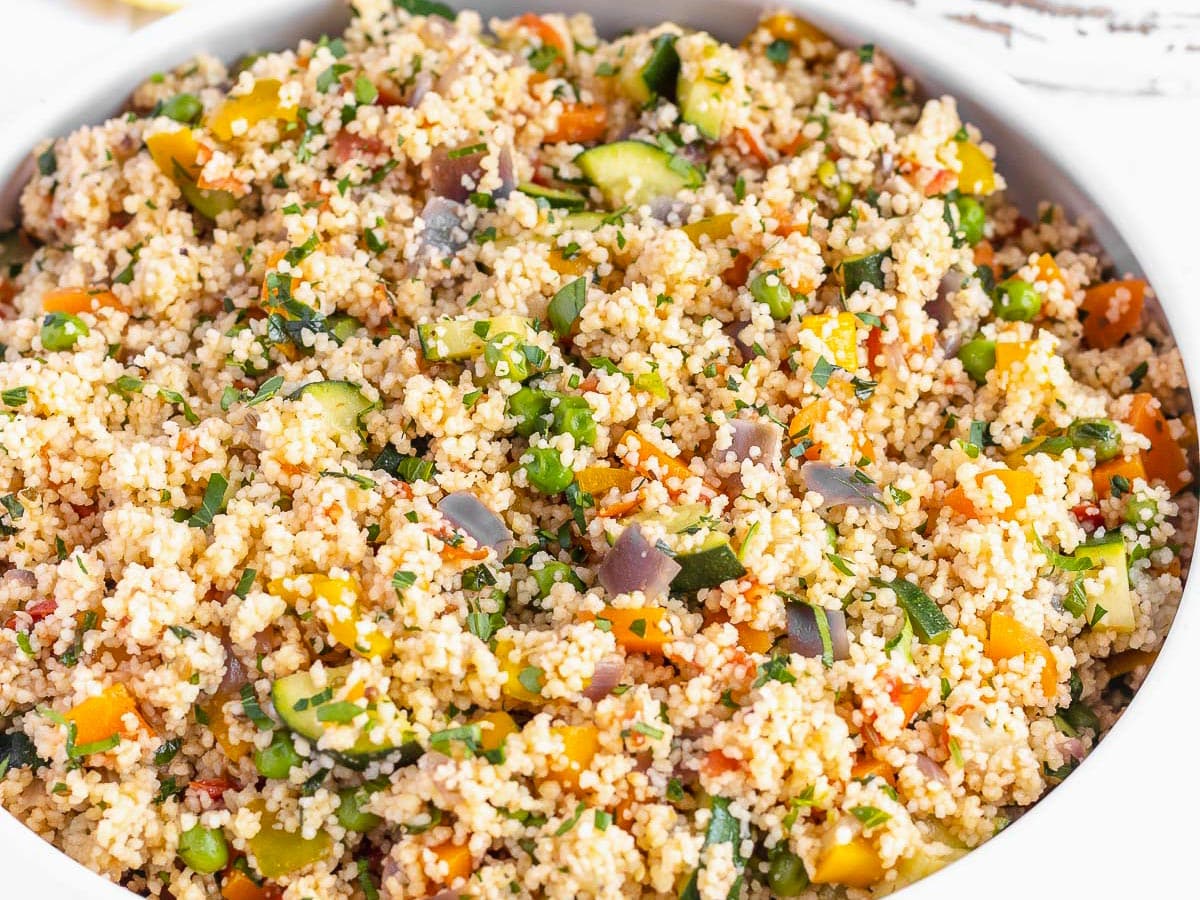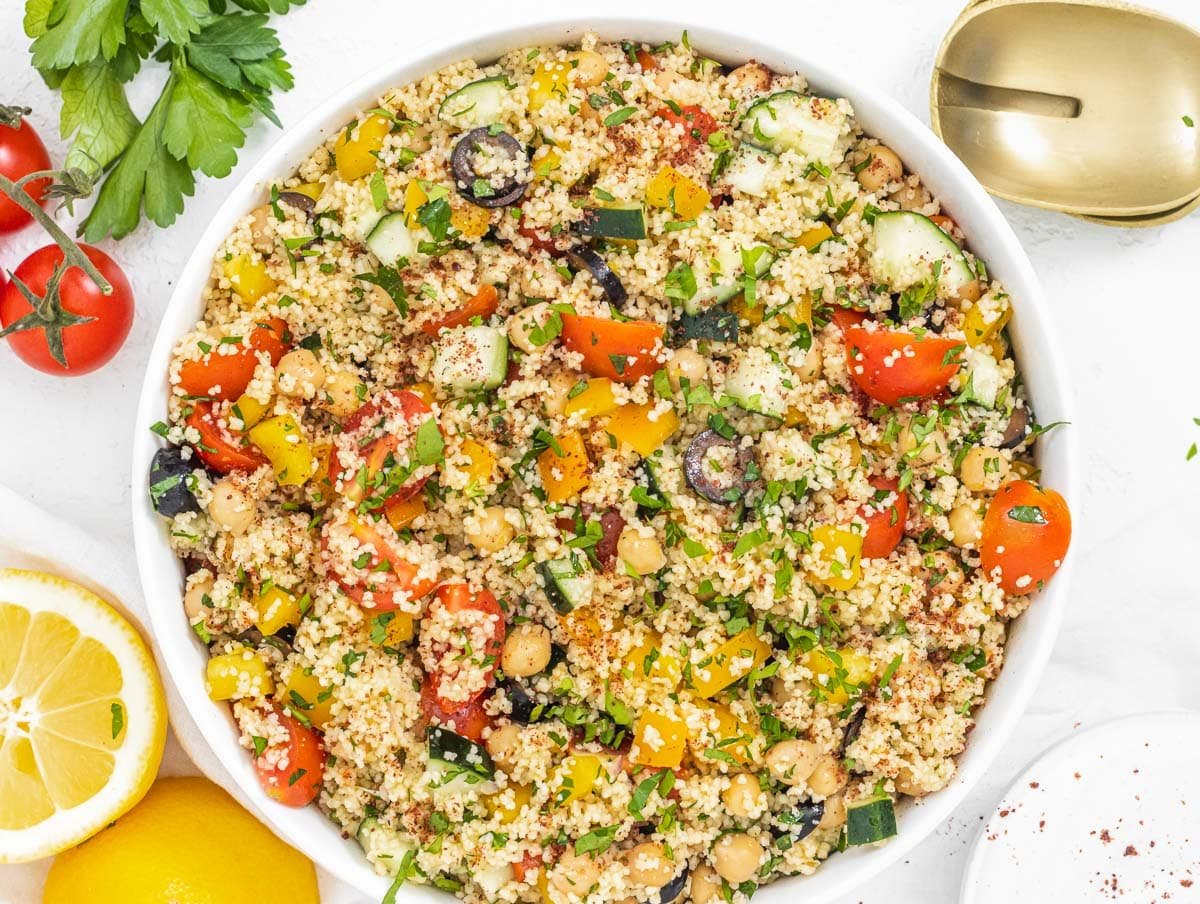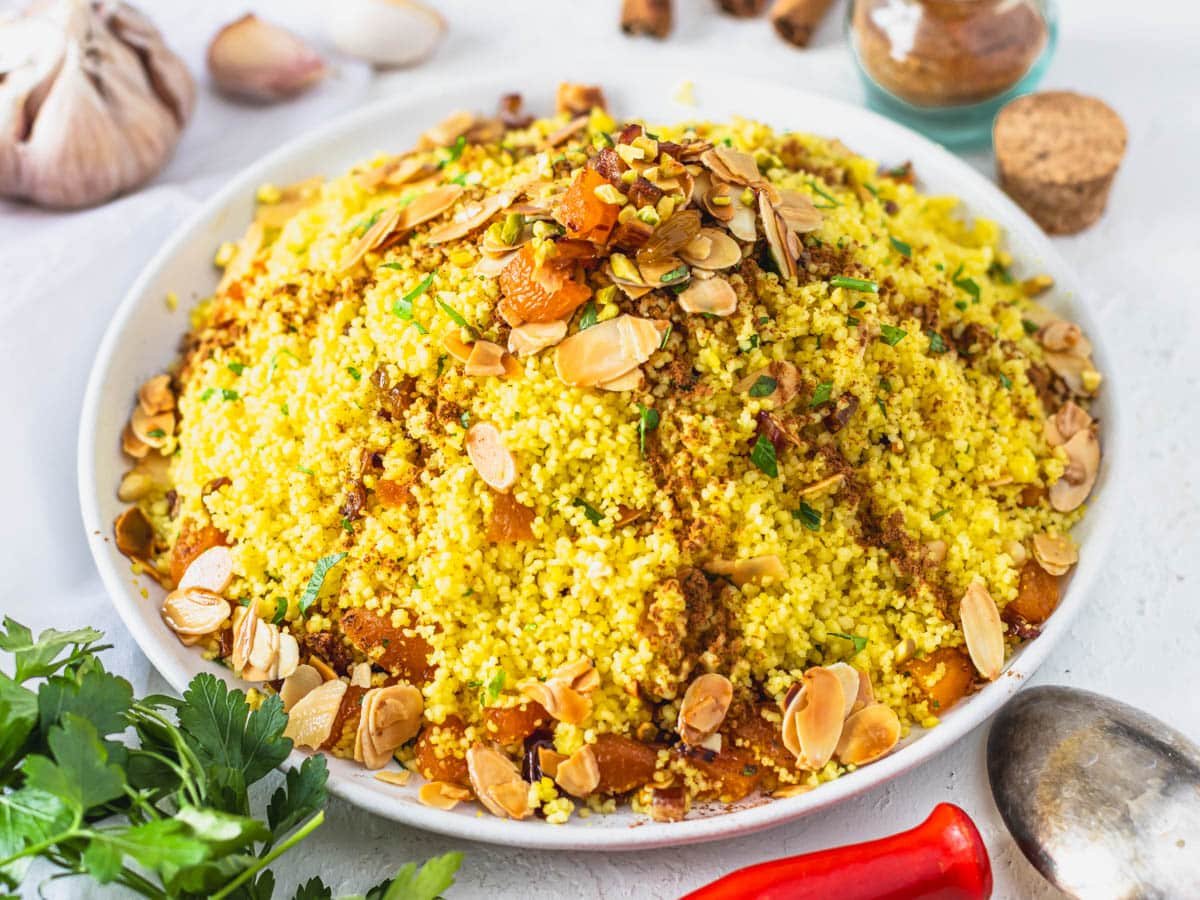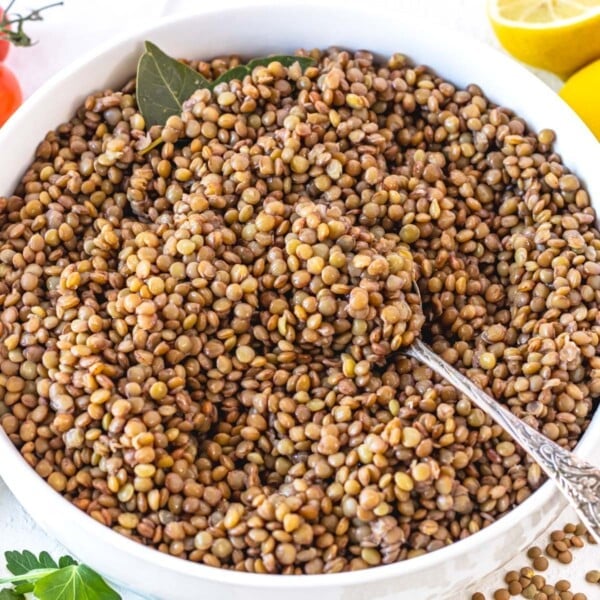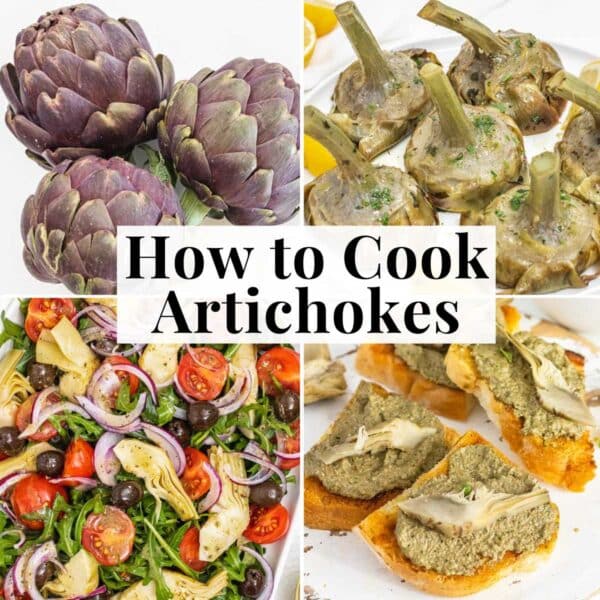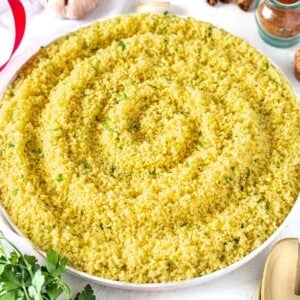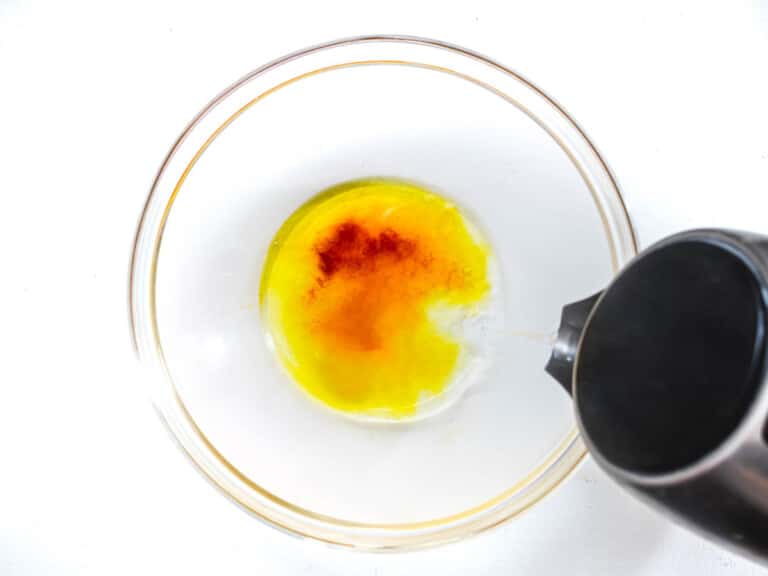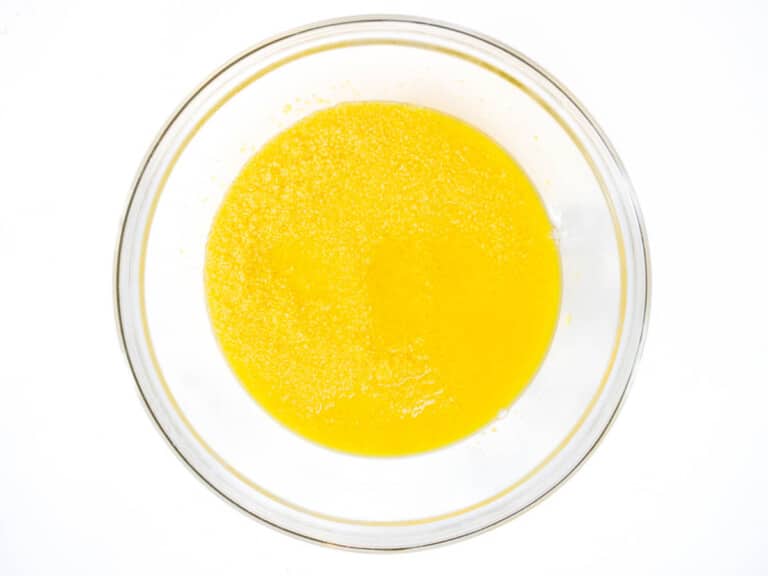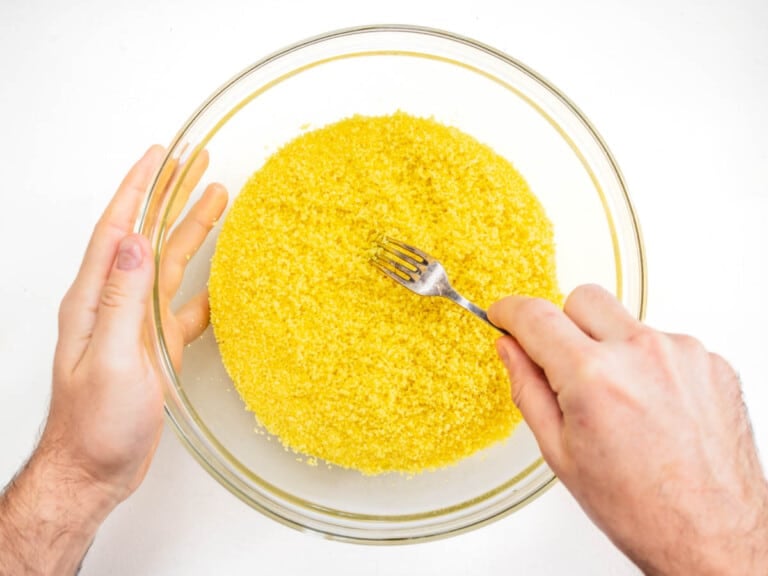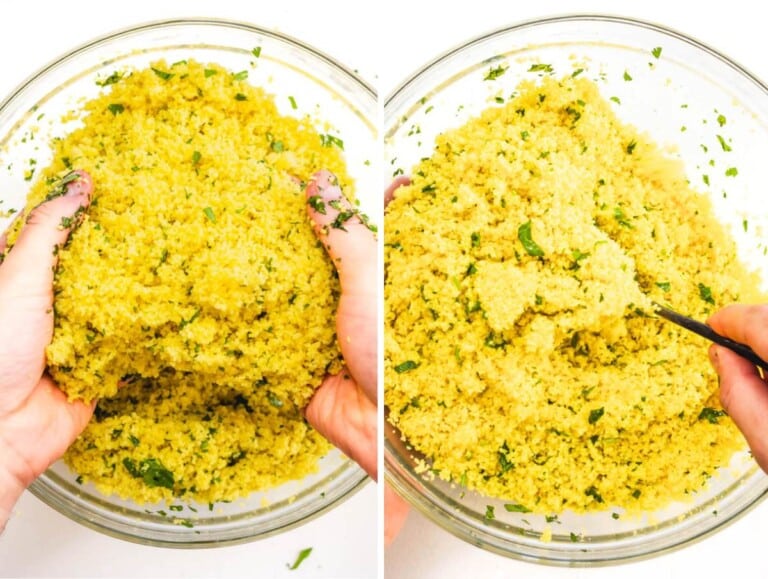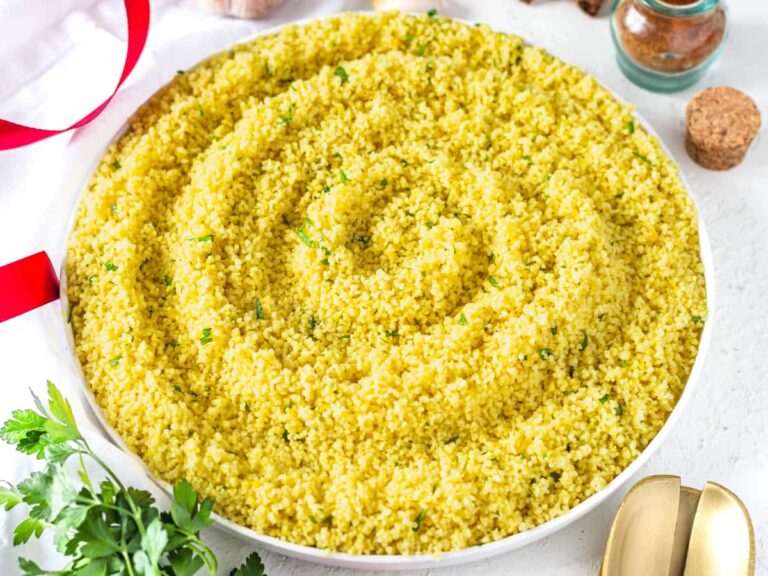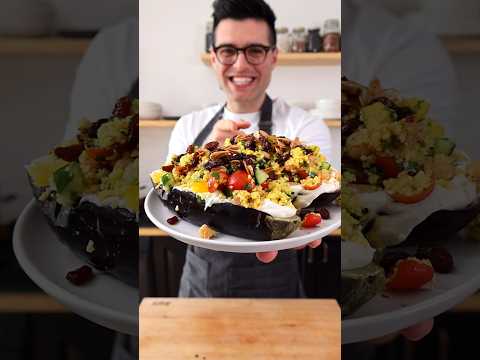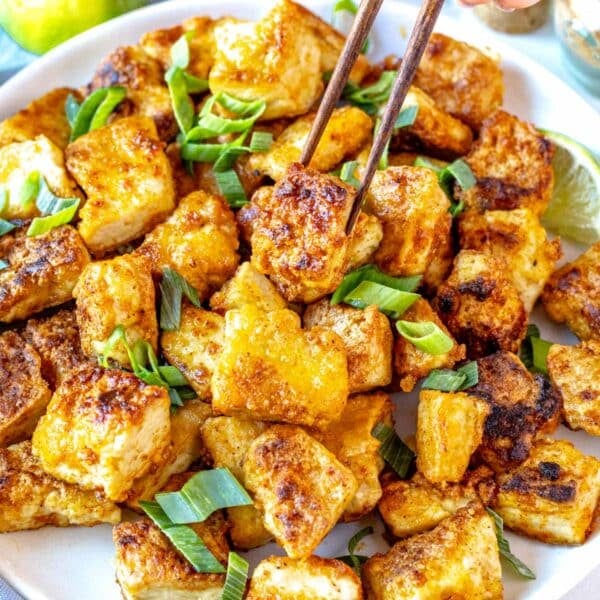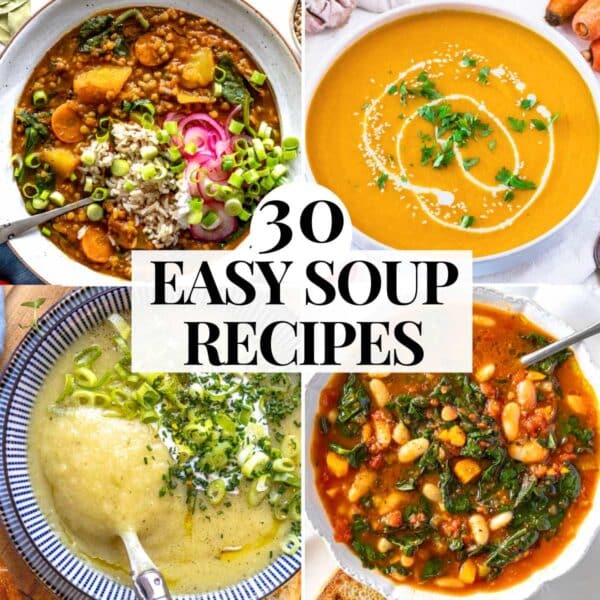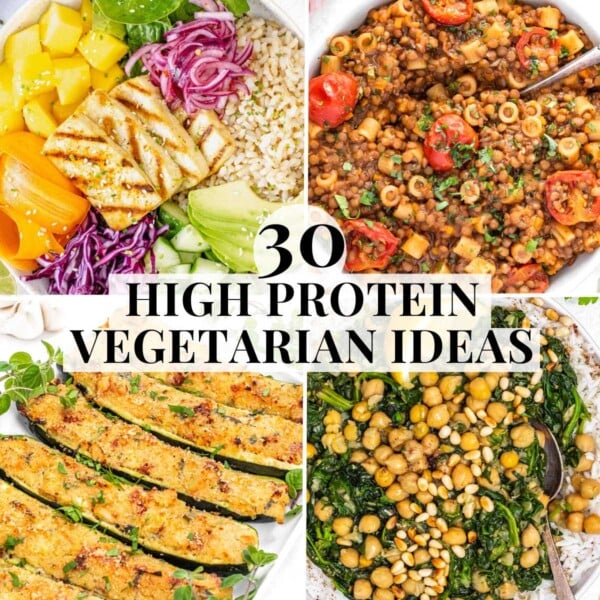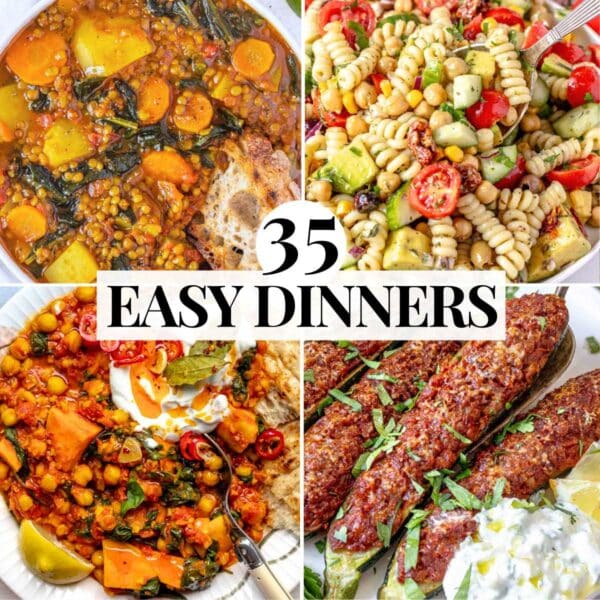Couscous is a versatile ingredient you can use as an alternative to rice, pasta, or grains. Dietary Note: this recipe is suitable for a vegetarian, vegan, and gluten-free diet.
What is couscous?
Ingredients & Substitutions
How to cook couscous
Serving Suggestions
Variation
Questions
Storage & Make Ahead
More basics
You can use plain, seasoned with extra virgin olive oil, lemon, and fresh herbs. Or you can make Moroccan couscous with toasted nuts, dried fruits, and spices. Its flavor and aroma are divine! Couscous is a favorite ingredient in the Mediterranean and North African countries because it can transform simple dishes like Moroccan carrot salad, lentil tabbouleh, and Shirazi salad into delicious and satisfying meals. Use it as a base to make grain bowls like this couscous with vegetables, couscous salad, or chickpea salad. Pair it with saucy vegetable and legume stews; it’ll absorb their flavors. You’ll love it with a creamy lentil curry, chickpea curry, or sweet potato curry. Not to mention our spinach stew, Tuscan bean stew, and lentil vegetable soup. Use it as a substitute for pasta or grains in pasta salad, barley salad, farro salad, or orzo salad. Its versatility and ease of use make it an excellent ingredient for your pantry. So don’t miss out on this beautiful ingredient; learn how to make couscous at home. It’s also popular in France and Italy, and especially Sicily.Traditional couscous is made with durum wheat semolina flour, the ingredient used to make most Italian dry pasta. It has a small granular shape; you can find it in most supermarkets pre-steamed and dried. Nowadays, you can find two main types of couscous in the supermarket. Traditional couscous and Israeli couscous.
What is Israeli Couscous?
This blog post is not about Israeli couscous, also known as pearl couscous, but I’ll give you a short intro to it anyway. It looks like tiny balls of toasted pasta made with semolina flour. In Israel, it’s called Ptitim. You can cook pearl couscous like pasta in a pot with salted boiling water.
Couscous
By couscous we mean traditional couscous, not pearl couscous. It’s sold in all supermarkets, looks like small granules of pasta, is pre-steamed and dried, and takes 10 minutes to prepare. There are two types of traditional couscous. White and whole wheat couscous. You can use either one.
Hot liquid
You can use boiling water, vegetable broth, or chicken broth. They should be hot, almost boiling.
Salt
Sea salt or kosher salt is best.
Olive oil
We recommend using extra virgin olive oil. Substitute regular olive oil, melted butter, non-dairy butter, ghee, or smen – a salted fermented butter with an intense flavor – for extra virgin olive oil. Extra virgin olive oil is the healthiest option as it contains heart-healthy fats and polyphenols.
Optional ingredients
Fresh herbs
You can add fresh flat-leaf parsley, coriander, or mint.
Saffron or Turmeric
Use a pinch of saffron or turmeric to add an appealing golden color.
Lemon juice
Prepare a few wedges of lemon to squeeze on the couscous before serving it. Heat your liquid of choice – water or vegetable broth – until it boils. You can do so with a kettle or a medium saucepan on the stove. In a large mixing bowl, add the saffron or turmeric and salt and dissolve them in 2 tablespoons of hot liquid. Add the couscous and cover it with the remaining hot water or broth. Stir to combine and set aside, covered with a lid, for 5 minutes. When all water has been absorbed, rake or fluff with a fork to separate its grains. Add olive oil and chopped parsley, coriander, or mint. Toss to combine, taste, and adjust for salt, and your basic couscous recipe is ready. Tip: you can toss with your hands or with a spoon. I find it easier to do it with my hands to break off eventual lumps. Its neutral flavor and fluffy texture are excellent with saucy dishes like stews, chunky soups, and salads. In Morocco, where couscous is akin to a national dish, it is often served on a serving platter topped with Tagines, warm and aromatic stews with vegetables, meat, or fish.
Couscous instead of pasta
Pile it on a serving platter and top it with one of these pasta sauces:
Lentil bolognese Sautéed Eggplants Marinara sauce Mushroom ragu
Or substitute it for pasta in this chickpea pasta salad, orzo salad, or vegan pasta salad.
Couscous instead of rice
Use it as a base for curries and stews such as:
Potato curry Lentil curry Tofu curry Cauliflower curry Chickpea curry Sweet potato curry Eggplant curry Tuscan bean stew Spinach stew Chickpea stew
Couscous in salads & bowls
Mix it in to add substance to salads and grain bowls
Lentil carrot salad Chickpea salad Moroccan carrot salad Lentil tabbouleh Shirazi salad Farro salad (instead of farro) Barley salad (instead of barley) Lentil sweet potato salad Cauliflower lentil salad
Couscous for stuffing vegetables
Stuffed eggplant with tahini and couscous salad Microwave sweet potato Stuffed bell peppers
Couscous as a starter or light dinner
Have it with other small dishes from the Mediterranean and Middle East. It’s delicious with:
Tzatziki Zaalouk Hummus Falafel Greek yogurt, Feta cheese, Labneh, and Yogurt Tahini Sauce Roasted zucchini, eggplant, and carrots Chopped tomatoes, cucumbers, olives, and caramelized onions.
They are then mixed in the couscous to create a wonderful and aromatic dish you can enjoy with some thick yogurt or as a base for other dishes. Check out our Moroccan couscous recipe.
Couscous with vegetables
Couscous with vegetables is a meal in its own right. Seasonal vegetables are sautéed with herbs and spices on a pan and then mixed with the couscous. It’s a nutritious and tasty recipe, excellent for making ahead and meal prep. Check out our couscous with vegetables.
Mediterranean couscous salad
Couscous salad is a refreshing dish with crunchy seasonal vegetables and a delicious vinaigrette with olive oil, lemon, garlic, and cumin. It’s excellent for meal prep; you can bring it to picnics and potlucks and work in a lunch box. Check out our couscous salad. This is enough for 5-7 servings (we make more on purpose as it keeps well for days), depending on the type of sauce or stew you serve it with. Consider about 1/3 cup or about 60 grams to serve one person.
Is couscous healthy?
Yes. We consider it a healthy food as it has virtually no fat or cholesterol, a good amount of plant-based protein, plenty of good carbs to keep you going for a long time, and dietary fiber. Try whole wheat couscous, which contains even more dietary fiber, for an even healthier option.
Couscous Nutrition Information
Nutritional values are for 1 cup of dry couscous (3-4 servings) cooked with water and no salt, seasoning, or fat. Data from the U.S. Department of Agricolture.
Calories: 591 Protein: 20g Carbohydrates: 122g of which sugars: 0.5g Fat: 0.8g
From a nutritional point of view, it makes sense to serve couscous with legumes such as chickpeas, lentils, and beans and legume derivatives such as tofu (tofu is made with soy, which is a legume), although that’s not strictly necessary in a single meal.Eating couscous with various legumes and vegetables will provide plenty of protein, fiber, minerals, and vitamins.Couscous contains gluten, and it is not suitable for people with celiac disease on a gluten-free diet. Storebought dry couscous keeps well in a dry corner of your pantry for up to 1 year. Refrigerator: cooked couscous keeps well in the fridge in an airtight container for one week. Freezer: spread the couscous over a large tray, put it in the freezer for two hours, then take it out, transfer it to a freezer-friendly container, and keep it for three months. Thaw & Reheat: Defrost at room temperature for an hour or in the fridge for several hours. Reheat in the microwave for 1 to 2 minutes or serve cold, mixed with a warm stew or veggies.
How to Cook Chickpeas
How to Cook Black Lentils
How to Cook Lentils
How to Cook Artichokes + Easy Recipes
Fried Tofu
30 Easy Soup Recipes
30 High Protein Vegetarian Meals
35 easy dinners
